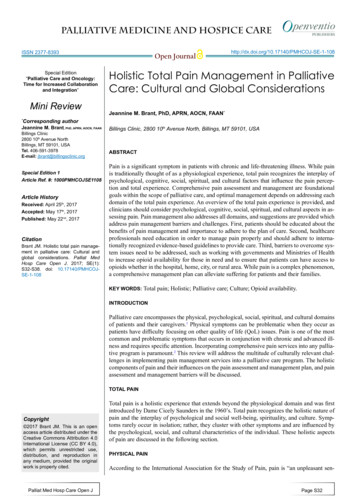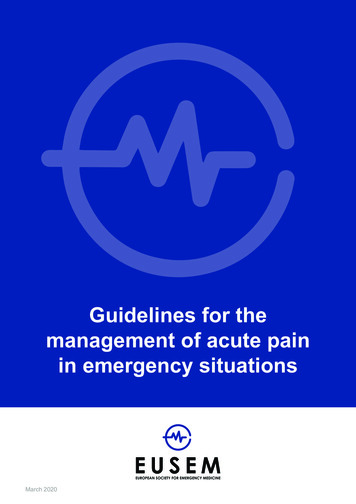
Transcription
Menu of Pain Management Clinic RegulationThe United States is in the midst of an unprecedented epidemic of prescription drug overdose deaths.1 Morethan 38,000 people died of drug overdoses in 2010, and most of these deaths (22,134) were caused byoverdoses involving prescription drugs.2 Three-quarters of prescription drug overdose deaths in 2010 (16,651)involved a prescription opioid pain reliever (OPR), which is a drug derived from the opium poppy or syntheticversions of it such as oxycodone, hydrocodone, or methadone.3 The prescription drug overdose epidemic hasnot affected all states equally, and overdose death rates vary widely between states.States have the primary responsibility to regulate and enforce prescription drug practice. Although state lawsare commonly used to prevent injuries and their benefits have been demonstrated for a variety of injury types,4there is little information on the effectiveness of state statutes and regulations designed to prevent prescriptiondrug abuse and diversion. This menu is a first step in assessing pain management clinic laws by creating aninventory of state legal strategies in this domain.IntroductionOne type of law aimed at preventing inappropriate prescribing is regulation of pain management clinics, oftencalled “pill mills” when they are sources of large quantities of prescriptions. Pill mills have become an increasingproblem in the prescription drug epidemic, and laws have been enacted to prevent these facilities fromprescribing controlled substances inappropriately. A law was included in this resource as a pain managementclinic regulation if it requires state oversight and contains other requirements concerning ownership andoperation of pain management clinics, facilities, or practice locations. For example, a law may specifyoperational and personnel requirements, inspection and complaint investigations, license procedures, health1For the purpose of this document, “overdose death” refers to death resulting from either intentional overdose oraccidental overdose, which could be caused by a patient being given the wrong drug, taking the wrong drug in error, ortaking too much of a drug inadvertently. CDC’s National Center for Injury Prevention and Control also refers to overdose asa drug poisoning, which may or may not result in death.2Centers for Disease Control and Prevention, Wide-ranging Online Data for Epidemiologic Research (WONDER) Database(2012) http://wonder.cdc.gov [hereinafter WONDER Database 2012].3Id.4Schieber RA, Gilchrist J, and Sleet DA. Legislative and Regulatory Strategies to Reduce Childhood Injuries, 10 FUTURE CHILD.1, 111–36 (2000).
and safety requirements, standards of care, or patient billing procedures. As of August 31, 2010, three states5had such pain management clinic laws; as of September 28, 2012, eight states did.6Definitions of Pain Management ClinicsAll eight states define pain management clinics within their laws.7 These definitions typically provide adescription of facility activities that constitute pain management services. For example, Louisiana’s painmanagement statute broadly reads, “‘Pain management clinic’ means a publicly or privately owned facility whichprimarily engages in the treatment of pain by prescribing narcotic medications.”8 Some pain management lawsspecify the types of drugs used in treatment that fall under pain management. In Texas, for example, “painmanagement clinic” means a “publicly or privately owned facility for which a majority of patients are issued on amonthly basis a prescription for opioids, benzodiazepines, barbiturates, or carisoprodol, but not includingsuboxone.”9 States such as Kentucky and Florida also include advertisement of pain management services intheir definitions.10 Kentucky’s statute provides that, “’pain management facility’ means a facility where themajority of patients of the practitioners at the facility are provided treatment for pain that includes the use ofcontrolled substances and: 1. The facility's primary practice component is the treatment of pain; or 2. The facilityadvertises in any medium for any type of pain management services.”11All eight states describe the level of pain management activities that will establish a facility as a painmanagement clinic. States use language that describes pain management activity as either the primary practicecomponent of such facilities,12 the provision of pain treatment to a “majority” (or more than 50 percent) offacility patients,13 or both in order to qualify as pain management clinics.14State Oversight of Pain Management ClinicsAll eight states require pain management clinics to register with the state or obtain a license or certificate fromthe state. For example, a Florida law provides that “[e]ach pain-management clinic must register with the5Florida, Louisiana, and Texas.Florida, Kentucky, Louisiana, Mississippi, Ohio, Tennessee, Texas, and West Virginia. As of July 2013, some of these stateshave passed additional laws and the number of states with pain management clinic laws has also increased to 11, with theaddition of Alabama, Georgia and Indiana. Discussion of these laws will be included in the next update of pain managementclinic laws.7In this menu, the first effective dates of the specific provisions referenced are cited as “[legal citation] (eff. [year]).” Wheredates were either not provided within the laws or were unclear due to multiple revisions, this fact is cited as “[legal citation](eff. date unclear, [estimated year]).”68LA. REV. STAT. ANN. § 40:2198.11(3) (eff. 2005).22 TEX. ADMIN. CODE § 195.1(2) (eff. 2010); TEX. OCC. CODE ANN. § 168.001 (eff. 2009).10See FLA. STAT. ANN. § 458.3265(1)(a)(1)(c)(I) (eff. 2010); FLA. STAT. ANN. § 459.0137(1)(a)(1)(c)(I) (eff. 2010); KY. REV. STAT.ANN. § 218A.175(1)(a)(2) (eff. 2012).11KY. REV. STAT. ANN. § 218A.175(1)(a).12Louisiana. See LA. REV. STAT. ANN. § 40:2198.11(3) (eff. 2005).13Florida, Mississippi, Tennessee, Texas, and West Virginia. See FLA. STAT. ANN. § 458.3265(1)(a)(1)(c)(II); FLA. STAT. ANN.§ 459.0137(1)(a)(1)(c)(II); 30-17 MISS. CODE R. § 2640:1.2(G) (eff. 2012); TENN. CODE ANN. § 63-1-301(5) (eff. 2011); 22 TEX.ADMIN. CODE § 195.1(2); TEX. OCC. CODE ANN. § 168.001; W. VA. CODE ANN. § 16-5H-2(d) (eff. 2012).14Kentucky and Ohio. See KY. REV. STAT. ANN. § 218A.175(1)(a) (eff. 2012); OHIO REV. CODE ANN. § 4731.054(A)(5)(a)(i), (ii) (eff.2011).91 Page
department,” with some exceptions.15 Mississippi law reads, “[a] pain management clinic may not operate inthe state of Mississippi without obtaining a certificate from the Mississippi State Board of MedicalLicensure.”16Tennessee law provides that “every pain management clinic shall submit an application to thedepartment [of health] . . . for a certificate to operate the clinic.”17State oversight in pain management clinic laws can include legal provisions establishing state inspectionauthority.18 In some states, inspections of pain management clinics are mandated at regular intervals todetermine compliance with license/administrative regulations.19 In West Virginia, for example, “[t]he Office ofHealth Facility Licensure and Certification shall inspect each pain management clinic annually, including a reviewof the patient records, to ensure that it complies with this article and the applicable rules.”20 Louisianaregulation states, “[a]fter the initial licensing survey, the department shall conduct a licensing survey at regularintervals as it deems necessary to determine compliance with licensing regulations. These surveys shall beunannounced to the clinic.”21 In other states, inspections are permissive wherein states have inspectionauthority and may inspect pain management clinics to ensure enforcement/compliance of rules.22 Tennesseelaw provides, “[e]ach board shall have the authority to inspect a pain management clinic which utilizes theservices of a practitioner licensed by that board. During such inspections, the authorized representatives of theboard may inspect all necessary documents and medical records to ensure compliance with this part and allother applicable laws and rules.”23 Texas has laws that include both permissive inspections and mandatedinspections in certain situations. Texas law states,The board may conduct inspections to enforce these rules, including inspections of a pain managementclinic and of documents of a physician's practice . . . . The board shall conduct inspections of painmanagement clinics if the board suspects that the ownership or physician supervision is not incompliance with board rules.24Some states also mandate the investigation of complaints in their pain management laws.25 A Kentuckyregulation provides that “[a]n unannounced inspection shall be conducted: (a) In response to a credible,relevant complaint or allegation; and (b) According to procedures established in this section.”26 A Texas statuteprovides that “[t]he board shall investigate a complaint alleging a violation of this chapter or a rule adoptedunder this chapter by a pain management clinic certified under this chapter or a physician who owns or operates15FLA. STAT. ANN. § 458.3265(1)(a)(2); FLA. STAT. ANN. § 459.0137(1)(a)(2).30-17 MISS. CODE R. § 2640:1.15 (B) (eff. 2012).17TENN. CODE ANN. § 63-1-306(c) (eff. 2011).18Analysis conducted is specifically for provisions within the pain clinic management laws and state agencies such as boardsof pharmacy may have general inspection authority over such facilities that dispense prescription drugs.19Four states, Florida, Kentucky, Louisiana, and West Virginia. See, e.g., FLA. STAT. ANN. § 458.3265(3) (eff. 2010); FLA. STAT.ANN § 459.0137(3) (eff. 2010); FLA. ADMIN. CODE ANN. r. 64B8-9.0132(2) (eff. 2010); FLA. ADMIN. CODE ANN. r. 64B15-14.0052(2)(eff. 2010); 902 KY. ADMIN. REGS. 20:420E (Sec. 10) (eff. 2012); LA. ADMIN. CODE. tit. 48, pt. I, § 7815(B) (eff. 2008); and W. VA.CODE ANN., § 16-5H-6(a) (eff. 2012).20W. VA. CODE ANN. § 16-5H-6(a).21LA. ADMIN. CODE tit. 48, pt. I, § 7815(B).22Three states: Kentucky, Tennessee, and Texas. See 902 KY. ADMIN. REGS. 20:420E (Sec. 5) (eff. 2012); TENN. CODE ANN. § 631-304 (eff. 2011) TEX OCC. CODE ANN. § 168.052 (eff. 2009); 22 TEX. ADMIN. CODE § 195.3 (eff. 2010).23TENN. CODE ANN. § 63-1-304.2422 TEX. ADMIN. CODE § 195.3.25Two states: Kentucky and Texas. See 902 KY. ADMIN. REGS. 20:420E (Sec. 10)(4); TEX. OCC. CODE ANN. § 168.053.26902 KY. ADMIN. REGS. 20:420E (Sec. 10)(4).162 Page
a clinic in the same manner as other complaints under this subtitle.”27 In other states, investigations ofcomplaints are permissive wherein states have the authority to investigate complaints.28 In Louisiana, forexample, “[t]he department may conduct a complaint investigation for any complaint received against a clinic. Acomplaint survey shall be unannounced to the clinic.”29Ownership and Operation Requirements for Pain Management ClinicsState pain management clinic laws often provide specific requirements pertaining to the ownership andoperation of pain management clinics. Many of the states with pain management laws require painmanagement clinic owners or medical directors or designated physicians to meet training requirements in painmedicine.30 These requirements include the completion of an accredited pain medicine fellowship or beingcertified in pain medicine or other approved certification. For example, a Louisiana statute requires that “allpain management clinics shall be owned and operated by a physician certified in the subspecialty of painmanagement by a member board of the American Boards of Medical Specialties.”31 A West Virginia statuteprovides that,The designated physician shall: B) Meet one of the following training requirements: (i) Complete a painmedicine fellowship that is accredited by the Accreditation Council for Graduate Medical Education orsuch other similar program as may be approved by the secretary; or (ii) Hold current board certificationby the American Board of Pain Medicine or current board certification by the American Board ofAnesthesiology or such other board certification as may be approved by the secretary.32Some states mandate that a pain management clinic owner(s) shall be a physician.33 For example, Ohio lawprovides that, “[i]n the operation of a pain management clinic, the following requirements shall be met: 1) Thepain management clinic shall be owned and operated by one or more physicians.”34 Similarly, West Virginia lawstates that, “[a]t least one owner shall be a physician actively licensed to practice medicine, surgery, orosteopathic medicine or surgery in this state.”35 Some states permit pain management clinic owners to bephysicians or non-physicians (for example, hospitals or public corporations).36 Other states require that themedical director must be a physician.37 For example, a Tennessee regulation requires that, “[a] pain27TEX. OCC. CODE ANN. § 168.053.Two states: Louisiana and Tennessee. See LA. ADMIN. CODE tit. 48, pt. I, § 7815(C);TENN. CODE ANN. § 63-1-305 (eff. 2011).29LA. ADMIN. CODE tit. 48, pt. I, § 7815(C).30Six states: Florida, Kentucky, Louisiana, Ohio, Tennessee, and West Virginia. See FLA. ADMIN. CODE ANN. r. 64B8-9.0131 (eff.2010); KY. REV. STAT. ANN. § 218A.175(3) (eff. 2012); LA. REV. STAT. ANN. § 40:2198.12(A) (eff. 2005); OHIO ADMIN. CODE 473129-01(B)(2) (eff. 2011);. TENN. COMP. R. & REGS.1200-34-01-.09 (eff. 2012); W. VA. CODE ANN. § 16-5H-4(3)(B) (eff. 2012).31LA. REV. STAT. ANN. § 40:2198.12 (A).32W. VA. CODE ANN. § 16-5H-4.33Four states: Kentucky (with an exception), Louisiana (with an exception), Ohio, and Texas. See KY. REV. STAT. ANN.§ 218A.175(2); 201 KY. ADMIN. REGS. 9:250E (Sec. 2)(1)(a) (eff. 2012); LA. REV. STAT. ANN. § 40:2198.12(A); LA. ADMIN. CODE. tit.48, pt. I, § 7803(A) (eff. 2008); OHIO REV. CODE ANN. § 4729.552(B)(1) (eff. 2011); OHIO ADMIN. CODE 4731-29-01(B)(1); TEX. OCC.CODE ANN. § 168.102(a) (eff. 2009).34OHIO ADMIN. CODE 4731-29-01(B)(1).35W. VA. CODE ANN. § 16-5H-4(a)(2).36Three states: Florida, Mississippi, and Tennessee. See FLA. STAT. ANN. § 458.3265(2) (eff. 2010); FLA. STAT. ANN.§ 459.0137(2) (eff. 2010); 30-17 MISS. CODE R. § 2640:1.15(C) (eff. 2012); TENN. COMP. R. & REGS.1200-34-01-.02 (eff. 2012).37Four states: Louisiana, Mississippi, Tennessee, and Texas. See LA. REV. STAT. ANN. § 40:2198.12(D)(2); 30-17 MISS. CODE R.§ 2640:1.15(C); TENN. CODE ANN. § 63-1-306(a) (eff. 2011); TEX. OCC. CODE ANN. § 168.102(a) (eff. 2009).283 Page
management clinic . . . must have a medical director who is a physician that practices in this state under anunrestricted and unencumbered license.”38All eight states have some form of provision prohibiting non-law-abiding or restricted licensees from becomingowners or employees of pain management clinics. Seven states have pain management clinic laws that stipulatethat pain management clinic owners and employees must not have been denied the privilege of prescribing,dispensing or administering any controlled substance during the course of their practice.39 Four states providethat pain management clinic owners and employees must not have held a restricted license to prescribe,dispense, or administer controlled substances.40 Four states also provide that pain management clinic ownersand employees must not have been disciplined for improper or inappropriate controlled substance prescribingor dispensing.41 An Ohio law encompasses all of the above characteristics and states,No physician owner of a pain management clinic, employee of the clinic, or person with whom the cliniccontracts for services shall:(1) Have ever been denied a license to prescribe, dispense, administer, supply, or sell a controlledsubstance by the drug enforcement administration or appropriate issuing body of any state orjurisdiction, based, in whole or in part, on the prescriber's inappropriate prescribing, dispensing,administering, supplying or selling a controlled substance or other dangerous drug.(2) Have held a license issued by the drug enforcement administration or a state licensing agency in anyjurisdiction, under which the person may prescribe, dispense, administer, supply or sell a controlledsubstance, that has ever been restricted, based, in whole or in part, on the prescriber's inappropriateprescribing, dispensing, administering, supplying, or selling a controlled substance or other dangerousdrug.(3) Have been subject to disciplinary action by any licensing entity that was based, in whole or in part, onthe prescribers inappropriate prescribing, dispensing, diverting, administering, supplying or selling acontrolled substance or other dangerous drug.42Five states require that pain management clinics may not be owned by any person who has been convicted of afelony. 43 For example, a Texas statute states that, “[a] pain management clinic may not be owned wholly orpartly by a person who has been convicted of, pled nolo contendere to, or received deferred adjudication for an38TENN. CODE ANN. § 63-1-306(a).Seven states: Florida, Kentucky, Louisiana, Mississippi, Ohio, Texas, and West Virginia. See e.g., FLA. STAT. ANN.§ 458.3265(1)(e)(2) (eff. 2010); FLA. STAT. ANN. § 459.0137(1)(e)(2) (eff. 2010); 201 KY. ADMIN. REGS. 9:250E (eff. 2012); LA.REV. STAT. ANN. § 40:2198.12(D)(1) (eff. 2005); 30-17 MISS. CODE R. § 2640:1.15(D)(1) (eff. 2012); OHIO ADMIN. CODE 4731-2901(D)(1) (eff. 2011); TEX. OCC. CODE ANN. § 168.201(a)(1); W. VA. CODE ANN. § 16-5H-4(a)(6)(B) (eff. 2012).40See 201 KY. ADMIN. REGS. 9:250E(Sec.5)(3); MISS. CODE R. § 2640:1.15(D)(2); OHIO ADMIN. CODE 4731-29-01(D)(2); TEX. OCC.CODE ANN. § 168.201(a)(2).41Four states: Kentucky, Mississippi, Ohio, and Texas. See 902 KY. ADMIN. REGS.20:420E(Sec.4)(2); MISS. CODE R.§ 2640:1.15(D)(3); OHIO ADMIN. CODE 4731-29-01(D)(3); TEX. OCC. CODE ANN. § 168.201(a)(3).42OHIO ADMIN. CODE 4731-29-01(D) (eff. 2011).43Louisiana, Mississippi, Tennessee, Texas, and West Virginia. LA. REV. STAT. ANN. § 40:2198.12; 30-17 MISS. CODE R.§ 2640:1.15(E)(1) (eff. 2012); TENN. CODE ANN. § 63-1-309(2)(b)(1) (eff. 2011); TEX. OCC. CODE ANN. § 168.201(b)(1) (eff. 2009);W. VA. CODE ANN. § 16-5H-4(a)(5) (eff. 2012).394 Page
offense that constitutes a felony . . . ”44 Some states specify that owners and employees must not have beenconvicted of felony for receipt of illicit and diverted drugs, including controlled substances.45 For example,Florida’s statute states,The department shall deny registration to any pain-management clinic owned by or with any contractualor employment relationship with a physician . . . [w]ho has been convicted of or pleaded guilty or nolocontendere to, regardless of adjudication, an offense that constitutes a felony for receipt of illicit anddiverted drugs, including a controlled substance listed in Schedule I, Schedule II, Schedule III, ScheduleIV, or Schedule V . . . in this state, any other state, or the United States.46Most states expressly state that the physician owner or medical director or designated physician of painmanagement clinics shall have active and unrestricted license to practice in state.47 For example, a Louisianastatute provides that, “[e]ach clinic shall be under the direction of a medical director who shall be a physicianwho: 1) possesses a current, unrestricted license from the board to practice medicine in Louisiana . . . ”48Four states require that a physician owner or medical director or designated physician shall be on site at theclinic for a specified percentage of operation time.49 For example, Kentucky statute provides that, “beginning onJuly 20, 2012, at least one (1) of the owners or an owner’s designee who is a physician employed by and underthe supervision of the owner shall be physically present practicing medicine in the facility for at least fiftypercent (50%) of the time that patients are present in the facility . . . ”50 Some states limit pain managementclinic dispensing quantities or specify additional requirements such as documentation or licensure for painmanagement clinic practitioners to dispense on premises. 51 For example, a West Virginia statute reads,A person may not dispense any medication, including a controlled substance . . . on the premises of alicensed pain management clinic unless he or she is a physician or pharmacist licensed in this state. Priorto dispensing or prescribing controlled substances . . . at a pain management clinic, the treatingphysician must access the Controlled Substances Monitoring Program database maintained by the Boardof Pharmacy to ensure the patient is not seeking controlled substances from multiple sources . . . A painmanagement clinic shall not dispense to any patient more than a seventy-two-hour supply of acontrolled substance. 5244TEX. OCC. CODE ANN. § 168.201(b)(1).Three states: Florida, Kentucky, and West Virginia. FLA. STAT. ANN. § 458.3265(1)(e)(3) (eff. 2010); FLA. STAT. ANN.§ 459.0137(1)(e)(3) (eff. 2010); 902 KY. ADMIN. REGS. 20:420 E (Sec. 4)(2)(c)(7)(d) (eff. 2012); W. VA. CODE ANN. § 16-5H4(a)(6)(C) (eff. 2012).46FLA. STAT. ANN. § 458.3265(1)(e)(3) (eff. 2010).47Seven states: Florida, Kentucky, Louisiana, Mississippi, Tennessee, Texas, and West Virginia. See e.g., FLA. ADMIN. CODEANN. r. 64B-7.001(2) (eff. 2011); KY. REV. STAT. ANN. § 218A.175 (2); LA. ADMIN. CODE tit. 48, pt. I, § 7831 (eff. 2008); 30-17MISS. CODE R. § 2640:1.15 (C)(2) (eff. 2012); TENN. CODE ANN. § 63-1-306(a) (eff. 2011); 22 TEX. ADMIN. CODE § 195.4 (c) (eff.2010); W. VA. CODE ANN. § 16-5H-4(a)(3)(A).48LA. ADMIN. CODE tit. 48, pt. I, § 7831.49Kentucky, Louisiana, Tennessee, and Texas. KY. REV. STAT. ANN. § 218A.175(3) (eff. 2012); LA. ADMIN. CODE tit. 48, pt. I,§ 7831(C); TENN. CODE ANN. § 63-1-309(2)(d) (eff. 2011); 22 TEX. ADMIN. CODE § 195.4(f)(1).50KY. REV. STAT. ANN. § 218A.175(3).51Three states: Florida, Tennessee, and West Virginia. See e.g., FLA. STAT. ANN. § 458.3265(2)(b), (2)(c) (eff. 2010); FLA. STAT.ANN. § 459.0137(2)(b), (2)(c)(eff. 2010);TENN. CODE ANN. § 63-1-309(2)(c); W. VA. CODE ANN. § 16-5H-4.52W. VA. CODE ANN. § 16-5H-4.455 Page
ConclusionThis inventory provides a collection of pain management clinic regulation laws. Additional legal strategiesrelated to prescription drug overdose fall outside the scope of this section. This inventory does not contain a fullassessment of all relevant prescription drug laws, which often include provisions setting forth professionallicensing penalties or criminal sanctions. Practitioners should consult with legal counsel to become fullyinformed of the legal landscape concerning prescription drugs and how the laws are implemented and enforcedin their state.This document was written by researchers in the Public Health Law Program in the Office for State, Tribal, Localand Territorial Support,53 with assistance from the Division of Unintentional Injury Prevention in the NationalCenter for Injury Prevention and Control.54 For further technical assistance with this inventory or prescription55drug laws, please contact the Public Health Law Program. For technical assistance on all other prescriptiondrug topics, please contact the Division of Unintentional Injury Prevention.56PHLP provides technical assistance and public health law resources to advance the use of law as a public healthtool. PHLP cannot provide legal advice on any issue and cannot represent any individual or entity in any matter.PHLP recommends seeking the advice of an attorney or other qualified professional with questions regarding theapplication of law to a specific circumstance. The findings and conclusions in this summary are those of theauthor and do not necessarily represent the official views of the Centers for Disease Control and Prevention.This menu includes laws enacted through September 28, 2012.53Akshara Menon, J.D., M.P.H., Carla Chen, J.D., Rina Lieberman, J.D., M.P.H., and Matthew Penn, J.D., M.L.I.S. We thankCatherine Clodfelter for her research and editorial assistance.5455Noah Aleshire, J.D. and Leonard Paulozzi, M.D., M.P.H.Public Health Law Program, Centers for Disease Control and Prevention, 4770 Buford Hwy. N.E., M.S. E-70, Atlanta, GA 30341.Telephone: (404) 498-0470. Fax: (404) 498-6882. Email: mpenn@cdc.gov. Web: http://www.cdc.gov/phlp.56Division of Unintentional Injury Prevention, National Center for Injury Prevention and Control, Centers for Disease Control andPrevention, 4770 Buford Hwy. N.E., M.S. F-62, Atlanta, GA 30341. Email: lpaulozzi@cdc.gov. oisoning/laws/index.html.6 Page
State pain management clinic laws often provide specific requirements pertaining to the ownership and operation of pain management clinics. Many of the states with pain management laws require pain management clinic owners or medical directors or designated physicians to meet training requirements in pain . . . . . Prevention,










